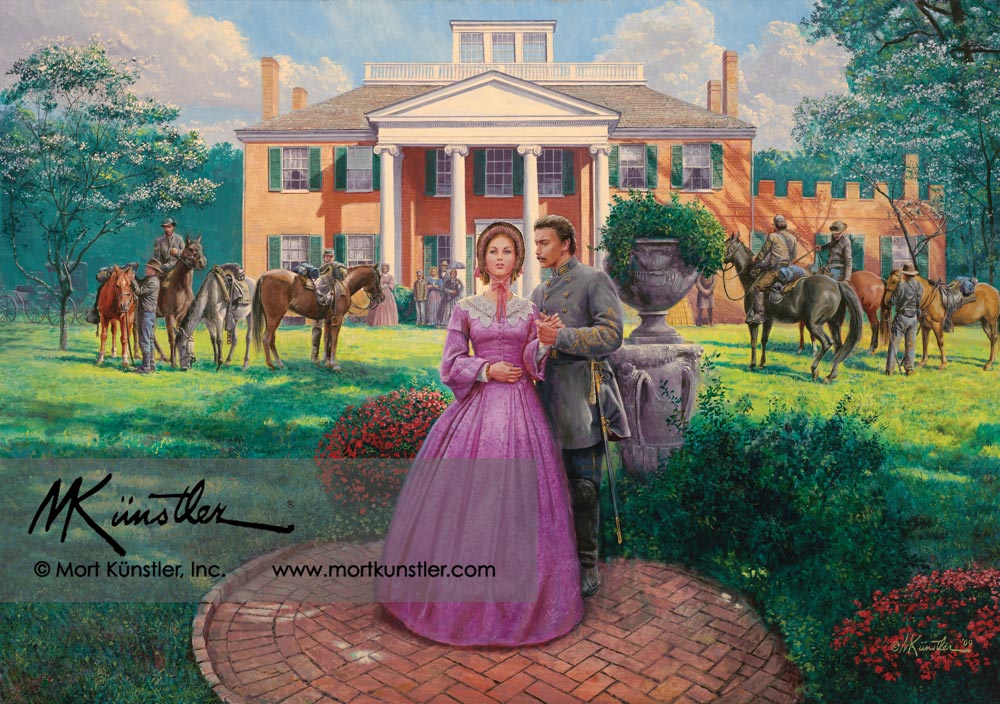Künstler
Duty, Honor and Tears
Duty, Honor and Tears
Couldn't load pickup availability
This is Mort Künstler print - Duty, Honor and Tears. Long Branch, Millwood, VA, May 24, 1862.
LIMITED EDITION PRINTS
Paper Prints
Reproduction technique: Fine offset lithography on neutral pH archival quality paper using the finest fade-resistant inks.
Each print is numbered and signed by the artist and accompanied by a Certificate of Authenticity.
Image Size: 19” x 27” • Overall Size: 24” x 31”
Signed & Numbered • Edition Size: 350
Signed Artist’s Proof • Edition Size: 50
Giclée Canvas Prints
Reproduction technique: Giclées are printed with the finest archival pigmented inks on canvas.
Each print is numbered and signed by the artist and accompanied by a Certificate of Authenticity.
Signature Edition 17” x 24”
Signed & Numbered • Edition Size: 50
Signed Artist’s Proof • Edition Size: 10
Classic Edition 21” x 30”
Signed & Numbered • Edition Size: 50
Signed Artist’s Proof • Edition Size: 10
Premier Edition 26” x 37”
Signed & Numbered • Edition Size: 15
Signed Artist’s Proof • Edition Size: 5
Historical Information
In Clarke County, deep in the shadow of the Blue Ridge Mountains,stands one of the most historic estates in all of America. Christened after a nearby stream, Long Branch is a beautifully designed home that boasts an impressive legacy. The original plot was drawn up by a young surveyor named George Washington and the farm was later owned by such regal proprietors as Lord Culpeper and Lord Fairfax. In 1842 Hugh Mortimer Nelson, a descendant of the original builder, purchased the property and completed the mansion.
During the outbreak of the American Civil War, Hugh Nelson found himself torn between a loyalty to his state and to his country. Representing Clarke County during Virginia’s Secession Convention, he tried to find an alternative to war. According to his colleagues he stood out as “one of the ablest of the Union men of the Virginia Convention of 1861, but who, like most of his party, buckled on his sword when all of Virginia’s efforts at pacification had failed.”
After raising a company of cavalry, he served under the flamboyant J.E.B. Stuart before being reassigned as the aide-de-camp for General Richard B. Ewell. While in the field, Nelson wrote home to his children, Hugh, Jr. and Nannie, expressing his desire to be reunited with his family.
In May of 1862, Ewell’s men marched through the Shenandoah Valley in order to join up with General Thomas “Stonewall” Jackson’s “Valley Campaign.” Captain Nelson remained on Ewell’s staff throughout the campaign, which eventually took them to the vicinity of Long Branch.
On the 23rd of May, the captain took leave of his post in order to make an overnight visit to his beloved home. Once there, he was reunited with his wife, Adelaide Holker Nelson, who had remained at Long Branch, despite its proximity to repeated skirmishes and guerrilla warfare. Over the course of that visit, the Nelsons shared what would ultimately be their last precious hours together. After returning to the ranks, Hugh went on to participate in the Seven Days Battles near Richmond, before succumbing to typhoid fever in August of 1862.
Mort Künstler’s Comments
The first time I saw Long Branch was about ten years ago. It is truly impressive. A second trip this year made me very excited about the potential for a painting using Long Branch as the background setting. I love incorporating buildings that are still standing today and are virtually unchanged from Civil War days.
The beauty and grandeur of Long Branch have been preserved for all to see, due to the foresight of a Baltimore textile executive, Harry Z. Isaacs, who bought the deteriorating manor house in 1986. He restored and refurbished it and formed the Harry Z. Isaacs Foundation to maintain Long Branch for all future generations to enjoy.
Upon reading the book Long Branch, by Christopher R. Fordney, I then came to understand a great deal about the plantation house and the families who lived there.
I realized that I had not done a romantic scene since Brief Encounter in 2005 and decided to look for a situation that would incorporate both the Nelson family, who lived there during the War Between the States, and their magnificent mansion. I found a passage in the book that described how Captain Hugh Nelson came home for an overnight visit on May 23, 1862. His parting from Mrs. Nelson the following morning was the perfect situation for what I wanted to paint. After going through sketches, photos and a complete tour of the grounds I rushed home to Oyster Bay to get started on the painting.
I deliberately placed Captain Nelson and his beautiful wife in the shadows cast by the early morning sun so that the dark of the bonnet would contrast with the white of the door. This creates strong visual interest and draws the eye to Adelaide Holker Nelson. Her likeness is based on a portrait that exists and is pictured in Fordney’s book. There is no known portrait of Hugh M. Nelson, Sr., so I based his likeness on the chance that his son, Hugh Nelson, Jr., bore a strong resemblance to his father. I was able to work with a photograph of the son that is also in the book. The time and the date of this farewell, early on May 24th, gave me the opportunity to paint bright morning sunlight with the brilliant color of azaleas as well as dogwoods in full bloom.
When the Nelsons parted on the morning of May 24th, there had to have been some tears. They would both go on to do their duty and preserve the family honor. There were many more tears a few months later. After the battle of Gaines Mill, Nelson fell ill, and died on August 6. The morning of May 24, 1862 was the last time they would see each other.
Share


Continue Shopping
See more of the Breagans' collection of manufacturers from all around the world
Subscribe to our emails
Subscribe to our mailing list for insider news, product launches, and more.

